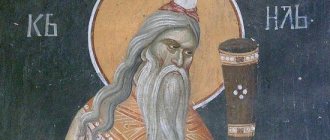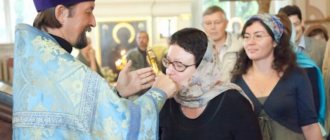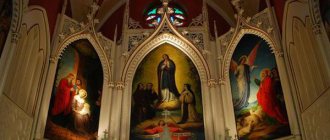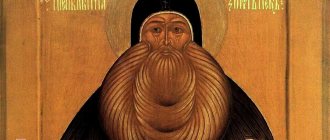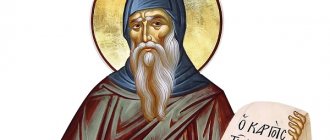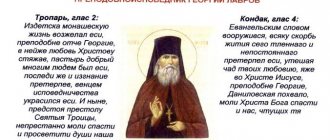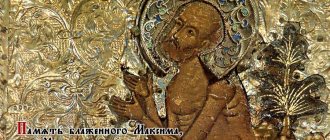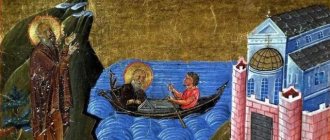| St. Maxim the Confessor |
Maximus the Confessor
(582 - 662), abbot, venerable. The famous figure and church teacher [1], a deep expert on Plato, Aristotle and the Neoplatonists, became famous in the history of the church for his energetic struggle against the Monothelite heresy Memory January 21, August 13, September 20 (Greek [2])
Born in Constantinople in 582 and raised in a pious noble Christian family. In his youth, he received an excellent, comprehensive education: he studied philosophy, grammar, rhetoric, was well-read in ancient authors and was fluent in theological dialectics.
When the Monk Maximus entered the public service, his knowledge and conscientiousness allowed him to become the first secretary of Emperor Heraclius (611-641).
But court life weighed heavily on him, and he retired to the Chrysopolis Monastery (on the opposite bank of the Bosphorus - now Scutari), where he took monastic vows. According to Brokgaz, removal of St. Maxim was caused by an imperial decree favorable to the new heresy (έκθεσις). With his humility, he soon gained the love of the brethren and was elected abbot of the monastery, but even in this rank, due to his extraordinary modesty, he, in his own words, “remained a simple monk.” In 633, at the request of one theologian, the future saint of Jerusalem Sophronius, the Monk Maxim left the monastery and left for Alexandria.
Saint Sophronius of Jerusalem had become known by that time as an irreconcilable opponent of the Monothelite heresy. Monothelitism found numerous supporters in Armenia, Syria, and Egypt. Heresy, strengthened by national hostility, became a serious threat to the church unity of the East. Orthodoxy's struggle against heresies was especially complicated by the fact that by 630 three patriarchal thrones in the Orthodox East were occupied by Monophysites: Constantinople - by Sergius, Antioch - by Athanasius, Alexandria - by Cyrus.
The path of the Monk Maxim from Constantinople to Alexandria lay through Crete, where his preaching work began. There he encountered the episcopate, which adhered to the heretical views of Severus and Nestorius. The monk spent about 6 years in Alexandria and its environs. In 638, Emperor Heraclius, together with Patriarch Sergius, trying to reduce religious differences, issued a decree, the so-called “Ekphesis” (“Exposition of Faith”), which finally commanded the doctrine of one will with two natures of the Savior to be professed. Defending Orthodoxy, the Monk Maxim addressed people of various ranks and classes, and these conversations were a success. “Not only the clergy and all the bishops, but also the people and all the secular leaders felt some kind of irresistible attraction to him,” testifies to his life.
At the end of 638, Patriarch Sergius I of Constantinople died, and in 641 Emperor Heraclius died. The imperial throne was occupied by the cruel and rude Constant II (642-668), an outspoken supporter of the Monothelites. The attacks of heretics on Orthodoxy intensified. The Monk Maximus went to Carthage and preached in it and the surrounding area for another 5 years. When the successor of Patriarch Sergius, Patriarch Pyrrhus, who had left Constantinople due to court intrigues and was a Monothelitian, arrived there, an open dispute took place between him and the Monk Maximus in June 645, at which Pyrrhus publicly admitted his errors and even wished to hand over to Pope Theodore a written renunciation of them. The Monk Maximus, together with Pyrrhus, went to Rome, where Pope Theodore accepted the repentance of the former patriarch and restored him to his rank.
| St. Maxim the Confessor. Fresco in the Church of Protata, Kareya, Athos (XIV century, author Manuel Panselin) |
In 647 the Monk Maximus returned to Africa.
There, at councils of bishops, monothelitism was condemned as heresy. In 648, instead of the “Ekphesis”, a new decree was issued, drawn up, on behalf of Constans II, by the Patriarch of Constantinople Paul - “Typos” (“Model of Faith”), which prohibited any reasoning either about one will or about two wills while recognizing two natures of the Lord Jesus Christ. Then the Monk Maxim turned to Pope Martin I (649-654), who succeeded Pope Theodore, with a request to bring the issue of monothelitism to a conciliar discussion of the entire Church. In October 649, the Lateran Council was assembled, at which 150 Western bishops and 37 representatives of the Orthodox East were present, among whom was St. Maximus the Confessor. The Council condemned monothelitism, and its defenders, the Patriarchs of Constantinople Sergius, Paul and Pyrrhus, were anathematized. When Constans II received the Council's determination, he ordered the capture of both Pope Martin and the Monk Maximus. This order was carried out a few years later, in 653. The Monk Maximus was arrested shortly before Pope Martin, along with his disciple Hierodeacon Anastasius. Reverend Maximus was accused of treason against the fatherland, in particular of speaking out against imperial power and aiding the Arabs who conquered Egypt and other African territories, and was imprisoned. In 656, two of the accused were sentenced to exile: Maximus was exiled to Thracian Vizia (modern Vize, Turkey), his student Anastasius was exiled to Pervera (on the border of Macedonia and Thessaly, modern Greece). Then the Monk Maxim was transferred to Pervera, where he remained in captivity for six years together with Anastasius.
Another follower of St. Maximus with the same name, Anastasius, who formerly held the position of papal apocrisiary in Constantinople, whose arrest together with Maximus is reported by some sources, was in fact exiled to Trebizond for refusing to accept the “Typos” of Emperor Constantos back in 648, and then, in 655 he was transferred to Mesemvria [3].
In 662, Maximus the Confessor was again brought to Constantinople and stood trial before the Patriarch of Constantinople and his Synod. Together with the Monks Maximus and Anastasius the monk, Anastasius the Apocrisiary was also recalled to Constantinople for trial [4]. He showered Maxim and his disciples with curses and insults ( "together with Pope Martin, Patriarch Sophronius and other Orthodox"
[5]), members of the church court handed over the convicts to the civil authorities in the person of the city prefect, who determined to subject them to the most severe torture. According to a lengthy Greek life, after the scourging, each of them had their tongue cut out, their right hand beheaded, and they were led through the city streets covered in blood [6]. Then the prefect ordered them to be imprisoned in different fortresses in distant Lazika [7] in the Caucasus.
June 8, 662, after arriving in the “land of Christ-loving Laz”
, the three prisoners were immediately separated by order of the Laz ruler.
Exhausted St. Maxim was immediately separated from his companions and carried on a stretcher woven from twigs to the “fortress of Schimarus, near the people called Alans”
(“ ομένων Ἀλανῶν"), where they placed it in conclusion [8].
Both Anastasievs were sent on horseback - the apocrisiary to the Bukolus fortress, located in the area called Misimiana “on the border with the Alans, who captured this fortress and hold it in their hands
,” and the monk to the Skotor fortress, which was located in Apsilia
“near Abasgia”
[ 9]. According to the life, here the Lord showed an indescribable miracle: they all acquired the ability to speak and write.
The Monk Maxim predicted his death, which followed on August 13, 662.
The Greek prologues on August 13 indicate the transfer of his relics to Constantinople; it could have been timed to coincide with the death of the monk. It is possible that the establishment of the memory on January 21 is due to the fact that the Feast of the Transfiguration of the Lord is celebrated on August 13. According to another opinion, as in the case of Saint Athanasius of Alexandria, “the transfer of the memory of St. Maximus to January 21 is explained, apparently, by the desire to put him on a par with the great teachers and confessors commemorated during January” before the memory of the Sixth Ecumenical Council [10 ]. L. G. Epifanovich believed that perhaps the celebration of “the transfer of the relics of St. Maxim"
August 13 refers to the transfer of the relics not to Constantinople, but to the church of the monastery of St.
Arseny at the Muri fortress [11]. According to Bishop Stefan (Kalaijishvili), with “a high degree of probability, perhaps this is a reference to the “translation of the relics of St.
Maxim to Constantinople" is associated with the severed right hand, which after the execution was hidden or lost, and then discovered and placed in one of the temples of Constantinople" [12].
At night, three miraculously revealed lamps were lit over the grave of St. Maximus and many healings were performed [13].
| Right hand (right) hand of St. Maximus the Confessor. Athos. Monastery of St. Pavel |
Right hand of St. Maximus the Confessor is kept on Mount Athos in the Monastery of St. Paul.
Which saints bore the name Maxim
Most of the saints named Maximus happened to live during times of persecution of Christians. They showed incredible dedication in defending the True Faith, despising all torment and thereby showing an example of true fidelity to Christ's teaching. Here are the names of these holy martyrs: Maximus of Adrianople, Maximus of Marcianopolis (Misian), Maximus of Asia, Maximus of Antioch, Maximus of Africa.
Particularly noteworthy are two saints who made a huge contribution to the struggle for the purity of Christ’s teaching and its dissemination: Maxim the Confessor and Maxim the Greek. Both of them were canonized as saints, and to this day the icon “Maxim the Confessor” and the icon “Maxim the Greek” are revered by the Orthodox.
Love
Maxim is a real romantic. For the sake of his beloved, he is ready for feats and rather unpredictable actions. With this behavior he wins women's hearts. It is important for him that his chosen one sincerely admires him.
He will be able to open his feelings only to the woman whom he will completely trust. He chooses an experienced, self-sufficient and powerful woman as his wife. His wife must fully share his aspirations and interests.
To build a happy relationship, Maxim should become less romantic and more realistic.
St. Reverend Maximus the Confessor
Saint Maximus was born in Constantinople in the 7th century. Thanks to his brilliant education and personal qualities, he took the position of first secretary under the emperor, but his rejection of the hustle and bustle of court life prompted him to take monastic vows.
Having become a monk, Maxim amazed everyone with his humility and wisdom, for which the monastic brethren elected him abbot of the Chrysopolis monastery. However, even here he did not become proud, but continued to remain as modest and pious as before.
At that time, Monothelitism was widespread, a heretical movement in Christianity that recognized Jesus Christ as having only one Divine nature. Monothelitism undermined the unity of the Eastern Church and contributed to discord between peoples.
It was in the fight against this heresy that Maximus the Preacher’s loyalty to the true teaching of the Savior was manifested. He read sermons, talked with high-ranking and ordinary believers, wrote many works interpreting the Holy Scriptures in order to debunk monothelitism, thereby gaining enormous popularity and respect among the laity, rulers and clergy.
But then Constance II, who adhered to the Monothelite heresy, ascended the imperial throne. In 649, the Lateran Council was held in Rome to discuss this issue. The most important role in the condemnation and anathematization of monothelitism, which was the result of the council, belongs to the Greek monks led by Maximus the Confessor.
Having received the papal encyclical recognizing the doctrine he professed as heresy, Emperor Constance in a rage threw the Monk Maximus into prison as a traitor. He was subjected to terrible torture, as a result of which he could no longer speak or write, but the Lord did not abandon the righteous man, and he regained these abilities again.
The Monk Maxim predicted in advance the day of his death - August 13, 662. Many miraculous healings took place at his grave, and the icon of St. Maximus the Confessor is revered by all zealots of the True Faith. According to tradition, the icon of Maxim the Confessor shows the image of a stern old man in monastic vestments with a scroll in his hands.
Major works
The main works of Maxim the Confessor:
- "Ambigva, or On various perplexities among Saints Dionysius and Gregory." This work is a combination of two independent works written at different times. This included an extensive work entitled "Ambigwy to John" and a less voluminous work "Ambigwy to Thomas";
- "Questions to Thalassia." In this book, Maxim the Confessor showed the best sides of his theological talent. The essay contains an accessible interpretation of difficult-to-understand passages of Holy Scripture. The work consists of 65 “question-answers” dedicated to the eternal and unchanging truths about God, the salvation of the soul of a believer;
- "Interpretation of the Lord's Prayer." In the work, the righteous man analyzes the text of the most important Christian prayer. The author explains why the Lord is called Father, what Kingdom is spoken of in the prayer address, who the evil one is, and also highlights other important points;
- "Ten Chapters on Virtue and Vice." In his work, the theologian focuses on the negative impact of sin. He calls pride the main cause of sinfulness. This is what unclean spirits use to lead a person into temptation. Quote from the work: “Beware of the mother of evils - pride, which is unreasonable love for your body”;
- "Mystagogy". The work is considered quite complex and multifaceted. “Mystagogy” is dedicated to the great sacrament of church liturgy. It examines the structure of worship, the features of its conduct in the temple, its role in the salvation of the soul of a Christian;
- "Chapters about love." The most famous work of Maximus the Confessor is devoted to the understanding of love for God, which is the highest virtue. In this work, the reverend elder lists the ways to achieve it, which are the purification of one’s own heart, the tireless struggle against vices and passions.
There are also theological works whose authorship is attributed to Maximus the Confessor, but is not fully confirmed. Such works include “A Brief Statement of Faith,” “Hymns,” and “Dialogues on the Holy Trinity.”
Reverend Maxim the Greek
Maxim the Greek was born in the 15th century into a wealthy Greek family. He received an excellent education, traveled a lot, studying science in various European countries, but chose to retire from the world to a monastery. After taking monastic vows on Mount Athos, becoming a monk, he did not abandon his academic studies and studied Greek manuscripts.
It was Maxim’s scholarship that became the reason why he was sent to distant Muscovy to translate Greek manuscripts into Slavic at the request of Grand Duke Vasily III. Maxim, who received the nickname the Greek in Rus', made a huge contribution to the spiritual enlightenment of Orthodox Rus'. He is the author of translations of many liturgical books and a number of his own works.
However, Maxim, faithful to Christian teaching, had a conflict with local churchmen because of their “acquisitiveness” and violation of the Savior’s covenants, which especially aggravated when Grand Duke Vasily decided to divorce his wife. In 1525, at the Local Council, he was accused of heresy, as well as relations with the Turks, and was imprisoned in the Joseph-Volotsky Monastery, where he was kept in very harsh conditions.
After 6 years, he was again summoned to the Council and this time accused of deliberately “damaging” liturgical books. Now the place of his imprisonment was a monastery in Tver, but the local bishop had deep respect for him, and therefore he was not kept so strictly, he had the right to read and write.
Only 20 years later, Maxim the Greek, never broken in spirit, was allowed to settle in the Trinity-Sergius Lavra, having lifted all church prohibitions from him. The monk devoted the rest of his life to translating the Psalter. He died in 1556 on the day when the memory of his heavenly patron, the Monk Maximus the Confessor, is celebrated, and was canonized only in 1988.
According to tradition, the icon of Maximus the Greek depicts him with a full beard, a cross in one hand and a scroll in the other.
“Even if the whole world takes communion, I alone will not receive communion.”
-Are you a Christian? - the chairman of the court roared when silence finally fell in the hall.
“By the grace of Christ, the God of all, I am a Christian,” the saint meekly answered.
- It is not true! - the chairman cried with feigned piety.
The interrogation began. The chairman tried this way and that to catch the confessor, bombarded him with questions, put forward a variety of accusations, but Maxim, with reasonable firmness and humility, consistently refuted everything said against him. Then they began to bring “witnesses” into the courtroom, exposing Maxim’s various “crimes.” But their slander also crumbled before the dignity of the saint’s answers. The trial ended in nothing. The trial of the opponent of heresy dragged on for many years.
The monk was either kept in prison, then brought in for interrogation, sent out with an escort from the capital, then returned back. Bishops and nobles came to him, persuaded him to stop persisting, promised him awards and titles with which the emperor would shower him as soon as he accepted the heresy, they said that the entire Church, together with the Patriarch of Constantinople, already professed monothelitism.
“Truly, all the power of heaven will not force me to do this,” the monk answered them with gentle simplicity, “for what would I answer - I don’t say to God, but to my conscience - if for the sake of human glory, which in itself has no existence, I swore an oath from faith, saving those who love it?
Throughout the trial, the monk behaved with dignity, not allowing himself any sharp attacks or pathetic exclamations about the inevitable punishment that would overtake his offenders. He was polite, reserved and calm. “When you are insulted by someone or humiliated in some way,” the saint wrote, while still free, in “Chapters on Love,” “beware of thoughts of anger, lest they, because of this insult, separate you from love, and move you into the realm of hatred.” "
At the last meeting, the judge, before announcing the verdict, without much hope of breaking St. Maximus, asked what he would do when he learned that the Roman bishops had also accepted monothelitism and received communion (that is, entered into church communion) with the Patriarch.
How does the icon of Maxim the Greek help?
St. Maximus the Greek is the patron of scientists, theologians, translators, students and seminarians, as well as missionaries, catechists and apologists. If we touch upon the meaning of the icon, then people turn to it to strengthen faith and spirit, especially during persecution for faith and unjust oppression by the authorities. In addition, the icon “St. Maxim the Greek” is capable of healing various diseases, as well as saving from despondency and depression.
Whatever icon of Maxim is present in your life, it will help you remain firm in your faith and resist temptations.
Days of remembrance of St. Maximus the Confessor - January 21, August 13
The days of memory of St. Maxim the Greek are January 21/February 3 and June 21/July 4.
Prayer to St. Maximus the Confessor
Reverend Father Maxima! Strengthen our cowardice and confirm us in faith, so that we undoubtedly hope to receive all the good things from the mercy of the Master through your prayers. By your intercession, ask from our All-Merciful God the peace of His Church, under the sign of the militant cross, agreement in faith and unity of wisdom, destruction of vanity and schism, confirmation in good deeds, healing for the sick, consolation for the sad, intercession for the offended, help for the needy. Help all of us, who flow to you with faith, through your intercession to the Lord, and guide us all in peace and repentance, let us end our lives, heirs of the Heavenly Kingdom, may we be with all the righteous, who have pleased our Lord Jesus Christ from time immemorial, to Him belongs all glory and honor. and worship, with His Beginning Father and with His Most Holy and Good and Life-Giving Spirit, now and ever and unto ages of ages. Amen.
Prayer to St. Maxim the Greek
Oh, sacred head, reverend father, most blessed Abvo Maxim, do not forget your poor to the end, but always remember us in your holy and auspicious prayers to God. Remember your flock, which you yourself shepherded, and do not forget to visit your children. Pray for us, holy father, for your spiritual children, as if you have boldness towards the Heavenly King, do not be silent for us to the Lord, and do not despise us, who honor you with faith and love. Remember us unworthy at the Throne of the Almighty, and do not stop praying for us to Christ God, for you have been given the grace to pray for us. We do not imagine that you are dead, even though you have passed away from us in body, but even after death you remain alive. Do not give up on us in spirit, keeping us from the arrows of the enemy and all the charms of the devil and the snares of the devil, our good shepherd. Knowing that you are truly alive even after death, we bow down to you and pray to you: pray for us to Almighty God, for the benefit of our souls, and ask us time for repentance, so that we may pass from earth to heaven without restraint, from the bitter ordeals of the demons of the air princes and may we be delivered from eternal torment, and may we be heirs of the Heavenly Kingdom with all the righteous, who from all eternity have pleased our Lord Jesus Christ, to Him belongs all glory, honor and worship, with His Beginning Father and with His Most Holy and Good and Life-Giving Spirit, now and ever and ever. Amen.
( 2 ratings, average: 5.00 out of 5)

